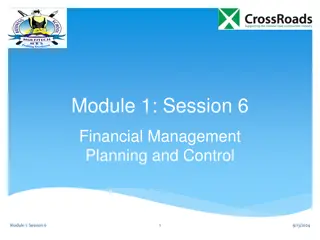Capital Budgeting in Financial Decisions
Capital budgeting, a crucial financial function, involves long-term investment decisions for assets like factories or machinery. Learn about its definition, importance, types, and decision-making processes.
Download Presentation

Please find below an Image/Link to download the presentation.
The content on the website is provided AS IS for your information and personal use only. It may not be sold, licensed, or shared on other websites without obtaining consent from the author.If you encounter any issues during the download, it is possible that the publisher has removed the file from their server.
You are allowed to download the files provided on this website for personal or commercial use, subject to the condition that they are used lawfully. All files are the property of their respective owners.
The content on the website is provided AS IS for your information and personal use only. It may not be sold, licensed, or shared on other websites without obtaining consent from the author.
E N D
Presentation Transcript
CAPITAL BUDGETING CAPITAL BUDGETING
CAPITAL BUDGETING CAPITAL BUDGETING Financing and investment of funds are two crucial financial functions. The investment of funds also termed as capital budgeting. It requires a number of decisionstobetakeninasituation,inwhichfundsareinvestedandbenefitsare expectedoveralongperiod. Capital budgeting means planning for capital assets. The capital budgeting decision means a decision as to whether or not money should be invested in long-term projectssuch as the setting up of a factory or installing a machinery or creating additional capacities to manufacture a part, which at present may be purchased from outside. It includes a financial analysis of the various proposals regarding capital expenditure to evaluate their impact on financial conditionofthecompanyandtochoosethebestoutofthevariousalternatives.
DEFINITION DEFINITION According to EE Nemmers, Capital budgeting or capital management may be defined as the process of determining which investment or allocation of long-term funds are to be made by an enterprise. According to Charles T Horngreen, Capital budgeting is long- term planning for making and financing proposed capital outlays.
IMPORTANCE OF CAPITAL BUDGETING IMPORTANCE OF CAPITAL BUDGETING DECISION DECISION Capital budgeting decisions should be taken after careful analyse and review. The importance of capital budgeting can be understood from the following points- Cost- Initial investment is substantial. Hence, commitment of resources should be made properly. Time- The effect of decision is known only in the near future and not immediately. Irreversibility- Decisions are irreversible and commitment should be made, on proper evaluation. Complexity-Decisions are based on forecasting of future events and inflows. Quantification of future events involves application of statistical and probabilistic techniques careful judgement and application of mind is necessary.
TYPES OF CAPITAL BUDGETING TYPES OF CAPITAL BUDGETING DECISION DECISION Capital budgeting decisions are classified in two ways. On the basis of firm's existence On the basis of decision situation
BASED ON FIRM'S EXISTENCE A. Cost Reduction Decision These decisions focus on reduction of operating cost and improving efficiency. They can be sub-classified into two parts- Replacement Decisions-The main objective to replacement is to improve operating efficiency and reduce costs which lead to increased profit, but the firm's revenue may remain unchanged. Modernization Decisions- As the time passes, assets become outdated and obsolete with technological changes. The firm must decide to replace these assets with new assets, so that firm may launch better product and operate more economically.
B. Revenue Expansion Decision These decisions focus on improving sales product lines, improved versions of products etc. These are sub-classified into two parts- Expansion Decisions-To add capacity to existing product lines to meet increased demand. To improve production facilities and to increase market share of existing products. Diversification Decisions-To diversify and enter into new product lines, venture into new markets to reduce business risk by dealing in different products and operating in different markets.
BASED ON NATURE OF DECISION A. Mutually Exclusive Decisions Decisions are said to be mutually exclusive, if two or more alternative proposals are such that the acceptance of one proposal will exclude acceptance of the other alternative proposals. B. Accept-Reject Decisions These are opposite to mutually exclusive decisions. The accept-reject decision occur when proposals are independent and do not compete with each other. The firm may accept or reject a proposal on the basis of a minimum return on required investments. C. Contingent Decisions These are dependent proposals. The investment in one proposal require investment in one or more other proposals.























